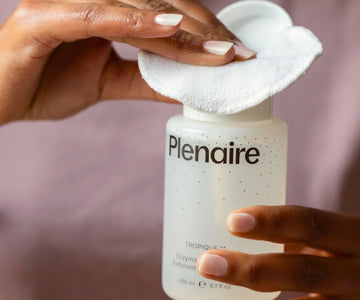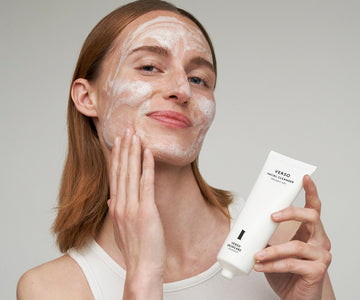دعونا نلقي نظرة فاحصة على العلم وراء كل منها لمساعدتك على فهم ما قد يكون الأفضل لبشرتك.
AHA (أحماض ألفا هيدروكسي)
أحماض ألفا هيدروكسي هي أحماض قابلة للذوبان في الماء ومصنوعة من الفواكه السكرية. تساعد هذه الأحماض على تقشير سطح بشرتك حتى تتمكن خلايا الجلد الجديدة ذات الصبغة الأكثر توازناً من التولد وتحل محلها. بعد الاستخدام، تشعر البشرة بأنها أكثر نعومة وتبدو منتعشة.
تشمل الأنواع الشائعة من أحماض ألفا هيدروكسي (AHAs) ما يلي:
- حمض الجليكوليك: مشتق من قصب السكر، وهو أصغر حمض ألفا هيدروكسي، مما يسمح له باختراق الجلد بعمق وسهولة. وهو فعال في علاج الخطوط الدقيقة وحب الشباب والرؤوس السوداء والبهتان والدهون.
- حمض اللاكتيك: يستخرج حمض اللاكتيك من اللاكتوز الموجود في الحليب، وهو أكثر لطفًا من حمض الجليكوليك ويساعد على تحسين عامل الترطيب الطبيعي للبشرة.
فوائد أحماض ألفا هيدروكسي:
- تعزيز الكولاجين وتدفق الدم.
- تحسين مظهر التجاعيد السطحية والخطوط الدقيقة.
- منع ظهور حب الشباب.
- تفتيح لون البشرة.
- زيادة امتصاص المنتج.
BHA (حمض بيتا هيدروكسي)
تذوب أحماض بيتا هيدروكسي في الزيت، مما يسمح لها بالتغلغل بشكل أعمق في المسام لإزالة خلايا الجلد الميتة والدهون الزائدة. حمض الساليسيليك هو أكثر أنواع أحماض بيتا هيدروكسي شيوعًا، والذي يستخدم غالبًا لعلاج البثور وأضرار أشعة الشمس.
فوائد BHA:
- ينظف المسام بعمق ويقشرها من الداخل إلى الخارج.
- له خصائص مضادة للالتهابات ومضادة للبكتيريا.
- مثالي لإدارة الرؤوس السوداء والرؤوس البيضاء.
- علاج فعال لمرض الوردية، بالإضافة إلى حب الشباب.
PHA (أحماض البوليهيدروكسي)
تعتبر أحماض البولي هيدروكسي من "أبناء عمومة" أحماض ألفا هيدروكسي ولكنها أكبر حجمًا من حيث الحجم الجزيئي، مما يعني أنها تخترق الجلد بشكل أبطأ، مما يقلل من فرصة التهيج. تشمل أحماض البولي هيدروكسي الشائعة الجلوكونولاكتون وحمض اللاكتوبيونيك.
فوائد PHAs:
- لطيف على البشرة، ومناسب لأنواع البشرة الحساسة.
- توفير فوائد مضادة للأكسدة.
- تقوية حاجز البشرة.
- يحافظ على الرطوبة في البشرة، ويوفر فوائد مضادة للشيخوخة.
ما هو الحمض الذي يجب عليك اختياره لتقشير وجهك؟
- نوع البشرة: أحماض ألفا هيدروكسي رائعة للبشرة الجافة بسبب خصائصها الجاذبة للماء، في حين أن أحماض بيتا هيدروكسي أفضل للبشرة الدهنية المعرضة لحب الشباب بسبب قدرتها على اختراق المسام بشكل أعمق. أحماض بولي هيدروكسي ممتازة للبشرة الحساسة أو الناضجة بسبب طبيعتها اللطيفة.
- تركيبة المنتج: يمكن العثور على هذه الأحماض في العديد من منتجات العناية بالبشرة، من المنظفات والتونر إلى الأمصال والمقشرات. والمفتاح هو التكامل التدريجي في نظام العناية بالبشرة .
- حساسية الشمس: تزيد أحماض ألفا هيدروكسي وأحماض بيتا هيدروكسي من حساسية البشرة للشمس. لذا، استخدمي دائمًا واقيًا من الشمس واسع الطيف عند استخدام هذه المنتجات.
تقدم أحماض ألفا هيدروكسي وأحماض بيتا هيدروكسي وأحماض بولي هيدروكسي فوائد متنوعة ويمكن أن تكون عوامل تغيير في روتين العناية بالبشرة . من خلال فهم ما يفعله كل حمض على أفضل وجه، يمكنك تصميم نهجك بما يتناسب مع احتياجات بشرتك والكشف عن بشرة أكثر صحة وإشراقًا.
سواء كنت تقوم بتحسين الملمس، أو مكافحة البثور ، أو تعزيز الترطيب، فإن هذه الأحماض القوية لديها حل لجميع مشاكل البشرة تقريبًا.





















